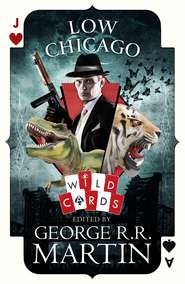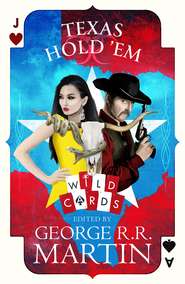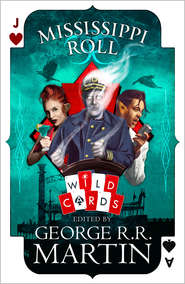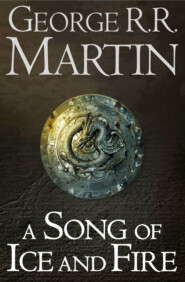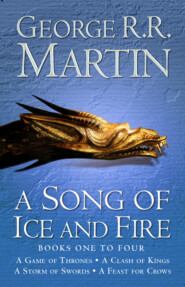По всем вопросам обращайтесь на: info@litportal.ru
(©) 2003-2024.
✖
Dangerous Women
Год написания книги
2019
Настройки чтения
Размер шрифта
Высота строк
Поля
Dangerous Women
Gardner Dozois
George Raymond Richard Martin
Commissioned by George R.R. Martin and Gardner Dozois, these tales of dangerous women by the most stellar names in fiction are available for the first time in three-volume paperback.George R.R. Martin is the bestselling author of A Song of Ice and Fire, the inspiration for HBO’s hit series GAME OF THRONES.This first volume features an original 35,000 word novella by George R.R. Martin.‘The Princess and the Queen' reveals the origins of the civil war in Westeros (before the events in A Game of Thrones), which is known as the Dance of the Dragons, pitting Targaryen against Targaryen and dragon against dragon.Other authors in this volume of warriors, bad girls and dragonriders include worldwide bestselling authors Brandon Sanderson, Lawrence Block and Nancy Kress.DANGEROUS WOMEN 1Gardner Dozois’s introductionGeorge R. R. Martin, ‘The Princess and the Queen’Carrie Vaughn, ‘Raisa Stepanova’Nancy Kress,’“Second Arabesque, Very Slowly’Lawrence Block, ‘I Know How to Pick ‘Em’Megan Abbott, ‘My Heart Is Either Broken’Joe R. Lansdale, ‘Wrestling Jesus’Brandon Sanderson, ‘Shadows for Silence in the Forests of Hell’
Dangerous Women
PART I
Copyright
HarperVoyager
An imprint of HarperCollinsPublishers Ltd
77–85 Fulham Palace Road,
Hammersmith, London W6 8JB
www.harpercollins.co.uk (http://www.harpercollins.co.uk/)
First published in Great Britain by HarperVoyager 2013
Copyright © George R.R. Martin and Gardner Dozois 2013
Dangerous Women / Edited by George R.R. Martin and Gardner Dozois
Jacket layout design © HarperCollinsPublishers Ltd 2014
Jacket photograph © Royal Armouries
The author of each individual story asserts their moral rights, including the right to be identified as the author of their work.
A catalogue copy of this book is available from the British Library.
This novel is entirely a work of fiction. The names, characters and incidents portrayed in it are the work of the author’s imagination. Any resemblance to actual persons, living or dead, events or localities is entirely coincidental.
All rights reserved under International and Pan-American Copyright Conventions. By payment of the required fees, you have been granted the non-exclusive, non-transferable right to access and read the text of this e-book on-screen. No part of this text may be reproduced, transmitted, down-loaded, decompiled, reverse engineered, or stored in or introduced into any information storage and retrieval system, in any form or by any means, whether electronic or mechanical, now known or hereinafter invented, without the express written permission of HarperCollins.
Source ISBN: 9780007549429
Ebook Edition © September 2014 ISBN: 9780008104948
Version: 2014-08-20
Copyright Acknowledgments
“The Princess and the Queen ” copyright © 2013 by George R. R. Martin
“Raisa Stepanova” copyright © 2013 by Carrie Vaughn
“Second Arabesque, Very Slowly” copyright © 2013 by Nancy Kress
“I Know How to Pick ’Em” copyright © 2013 by Lawrence Block
“My Heart Is Either Broken” copyright © 2013 by Megan Abbott
“Wrestling Jesus” copyright © 2013 by Joe R. Lansdale
“Shadows for Silence in the Forests of Hell” copyright © 2013 by Brandon Sanderson
Dedication
To Jo Playford, my dangerous minion.
George R.R. Martin
Introduction by Gardner Dozois
Genre fiction has always been divided over the question of just how dangerous women are.
In the real world, of course, the question has long been settled. Even if the Amazons are mythological (and almost certainly wouldn’t have cut their right breasts off to make it easier to draw a bow if they weren’t), their legend was inspired by memory of the ferocious warrior women of the Scythians, who were very much not mythological. Gladiatrix, women gladiators, fought other women – and sometimes men – to the death in the arenas of Ancient Rome. There were female pirates like Anne Bonny and Mary Read, and even female samurai. Women served as frontline combat troops, feared for their ferocity, in the Russian army during World War II, and serve so in Israel today. Until 2013, women in the U.S. forces were technically restricted to “noncombat” roles, but many brave women gave their lives in Iraq and Afghanistan anyway, since bullets and land mines have never cared whether you’re a noncombatant or not. Women who served as Women Airforce Service Pilots for the United States during World War II were also limited to noncombat roles (where many of them were nevertheless killed in the performance of their duties), but Russian women took to the skies as fighter pilots, and sometimes became aces. A Russian female sniper during World War II was credited with more than fifty kills. Queen Boudicca of the Iceni tribe led one of the most fearsome revolts ever against Roman authority, one that was almost successful in driving the Roman invaders from Britain, and a young French peasant girl inspired and led the troops against the enemy so successfully that she became famous forever afterwards as Joan of Arc.
On the dark side, there have been female “highwaymen” like Mary Frith and Lady Katherine Ferrers and Pearl Hart (the last person to ever rob a stagecoach); notorious poisoners like Agrippina and Catherine de Medici, modern female outlaws like Ma Barker and Bonnie Parker, even female serial killers like Aileen Wuornos. Elizabeth Báthory was said to have bathed in the blood of virgins, and even though that has been called into question, there is no doubt that she tortured and killed dozens, perhaps hundreds, of children during her life. Queen Mary I of England had hundreds of Protestants burnt at the stake; Queen Elizabeth of England later responded by executing large numbers of Catholics. Mad Queen Ranavalona of Madagascar had so many people put to death that she wiped out one-third of the entire population of Madagascar during her reign; she would even have you executed if you appeared in her dreams.
Popular fiction, though, has always had a schizophrenic view of the dangerousness of women. In the science fiction of the 1930s, ’40s, and ’50s, women, if they appeared at all, were largely regulated to the role of the scientist’s beautiful daughter, who might scream during the fight scenes but otherwise had little to do except hang adoringly on the arm of the hero afterwards. Legions of women swooned helplessly while waiting to be rescued by the intrepid jut-jawed hero from everything from dragons to the bug-eyed monsters who were always carrying them off for improbable purposes either dietary or romantic on the covers of pulp SF magazines. Hopelessly struggling women were tied to railroad tracks, with nothing to do but squeak in protest and hope that the Good Guy arrived in time to save them.
And yet, at the same time, warrior women like Edgar Rice Burroughs’s Dejah Thoris and Thuvia, Maid of Mars, were every bit as good with the blade and every bit as deadly in battle as John Carter and their other male comrades, female adventuresses like C. L. Moore’s Jirel of Joiry swashbuckled their way through the pages of Weird Tales magazine (and blazed a trail for later female swashbucklers like Joanna Russ’s Alyx); James H. Schmitz sent Agents of Vega like Granny Wannatel and fearless teenagers like Telzey Amberdon and Trigger Argee out to battle the sinister menaces and monsters of the spaceways; and Robert A. Heinlein’s dangerous women were capable of being the captain of a spaceship or killing enemies in hand-to-hand combat. Arthur Conan Doyle’s sly, shady Irene Adler was one of the only people ever to outwit his Sherlock Holmes, and probably one of the inspirations for the legions of tricky, dangerous, seductive, and treacherous “femmes fatale” who featured in the works of Dashiell Hammett and James M. Cain and later went on to appear in dozens of films noir, and who still turn up in the movies and on television to this day. Later television heroines such as Buffy the Vampire Slayer and Xena, Warrior Princess, firmly established women as being formidable and deadly enough to battle hordes of fearsome supernatural menaces, and helped to inspire the whole subgenre of paranormal romance, which is sometimes unofficially known as the “kick-ass heroine” genre.
Like our anthology Warriors, Dangerous Women was conceived of as a cross-genre anthology, one that would mingle every kind of fiction, so we asked writers from every genre – science fiction, fantasy, mystery, historical, horror, paranormal romance, men and women alike – to tackle the theme of “dangerous women,” and that call was answered by some of the best writers in the business, including both new writers and giants of their fields like Diana Gabaldon, Jim Butcher, Sharon Kay Penman, Joe Abercrombie, Carrie Vaughn, Joe R. Lansdale, Lawrence Block, Cecelia Holland, Brandon Sanderson, Sherilynn Kenyon, S. M. Stirling, Nancy Kress, and George R.R. Martin.
Here you’ll find no hapless victims who stand by whimpering in dread while the male hero fights the monster or clashes swords with the villain, and if you want to tie these women to the railroad tracks, you’ll find you have a real fight on your hands. Instead, you will find sword-wielding women warriors; intrepid women fighter pilots and far-ranging spacewomen; deadly female serial killers; formidable female superheroes; sly and seductive femmes fatale; female wizards; hard-living bad girls; female bandits and rebels; embattled survivors in postapocalyptic futures; female private investigators; stern female hanging judges; haughty queens who rule nations and whose jealousies and ambitions send thousands to grisly deaths; daring dragonriders; and many more.
Enjoy!
George R.R. Martin
Hugo, Nebula, and World Fantasy Award – winner George R.R. Martin, New York Times bestselling author of the landmark A Song of Ice and Fire fantasy series, has been called “the American Tolkien.”
Born in Bayonne, New Jersey, George R.R. Martin made his first sale in 1971, and soon established himself as one of the most popular SF writers of the seventies. He quickly became a mainstay of the Ben Bova Analog with stories such as “With Morning Comes Mistfall,” “And Seven Times Never Kill Man,” “The Second Kind of Loneliness,” “The Storms of Windhaven” (in collaboration with Lisa Tuttle, and later expanded by them into the novel Windhaven), “Override,” and others, although he also sold to Amazing, Fantastic, Galaxy, Orbit, and other markets. One of his Analog stories, the striking novella “A Song for Lya,” won him his first Hugo Award, in 1974.
By the end of the seventies he had reached the height of his influence as a science fiction writer, and was producing his best work in that category with stories such as the famous “Sandkings,” his best-known story, which won both the Nebula and the Hugo in 1980 (he’d later win another Nebula in 1985 for his story “Portraits of His Children”); “The Way of Cross and Dragon,” which won a Hugo Award in the same year (making Martin the first author ever to receive two Hugo Awards for fiction in the same year): “Bitterblooms”; “The Stone City”; “Starlady”; and others. These stories would be collected in Sandkings, one of the strongest collections of the period. By now he had mostly moved away from Analog, although he would have a long sequence of stories about the droll interstellar adventures of Haviland Tuf (later collected in Tuf Voyaging) running throughout the eighties in the Stanley Schmidt Analog, as well as a few strong individual pieces such as the novella “Nightflyers.” Most of his major work of the late seventies and early eighties, though, would appear in Omni. The late seventies and eighties also saw the publication of his memorable novel Dying of the Light, his only solo SF novel, while his stories were collected in A Song for Lya, Sandkings, Songs of Stars and Shadows, Songs the Dead Men Sing, Nightflyers, and Portraits of His Children. By the beginning of the eighties he’d moved away from SF and into the horror genre, publishing the big horror novel Fevre Dream, and winning the Bram Stoker Award for his horror story “The Pear-Shaped Man” and the World Fantasy Award for his werewolf novella “The Skin Trade.” By the end of that decade, though, the crash of the horror market and the commercial failure of his ambitious horror novel The Armageddon Rag had driven him out of the print world and to a successful career in television instead, where for more than a decade he worked as story editor or producer on such shows as the new Twilight Zone and Beauty and the Beast.
After years away, Martin made a triumphant return to the print world in 1996 with the publication of the immensely successful fantasy novel A Game of Thrones, the start of his Song of Ice and Fire sequence. A freestanding novella taken from that work, “Blood of the Dragon,” won Martin another Hugo Award in 1997. Further books in the Song of Ice and Fire series—A Clash of Kings, A Storm of Swords, A Feast for Crows, and A Dance with Dragons, have made it one of the most popular, acclaimed, and bestselling series in all of modern fantasy. Recently, the books were made into an HBO TV series, Game of Thrones, which has become one of the most popular and acclaimed shows on television, and made Martin a recognizable figure well outside of the usual genre boundaries, even inspiring a satirical version of him on Saturday Night Live. Martin’s most recent books are the latest book in the Ice and Fire series, A Dance with Dragons; a massive retrospective collection spanning the entire spectrum of his career, GRRM: A RRetrospective; a novella collection, Starlady and Fast-Friend; a novel written in collaboration with Gardner Dozois and Daniel Abraham, Hunter’s Run; and, as editor, several anthologies edited in collaboration with Gardner Dozois, including Warriors, Songs of the Dying Earth, Songs of Love and Death, and Down These Strange Streets, and several new volumes in his long-running Wild Cards anthology series, including Suicide Kings and Fort Freak. In 2012, Martin was given the Life Achievement Award by the World Fantasy Convention.
Here he takes us to the turbulent land of Westeros, home to his Ice and Fire series, for the bloody story of a clash between two very dangerous women whose bitter rivalry and ambition plunges all of Westeros disastrously into war.
THE PRINCESS AND THE QUEEN, OR, THE BLACKS AND THE GREENS
Gardner Dozois
George Raymond Richard Martin
Commissioned by George R.R. Martin and Gardner Dozois, these tales of dangerous women by the most stellar names in fiction are available for the first time in three-volume paperback.George R.R. Martin is the bestselling author of A Song of Ice and Fire, the inspiration for HBO’s hit series GAME OF THRONES.This first volume features an original 35,000 word novella by George R.R. Martin.‘The Princess and the Queen' reveals the origins of the civil war in Westeros (before the events in A Game of Thrones), which is known as the Dance of the Dragons, pitting Targaryen against Targaryen and dragon against dragon.Other authors in this volume of warriors, bad girls and dragonriders include worldwide bestselling authors Brandon Sanderson, Lawrence Block and Nancy Kress.DANGEROUS WOMEN 1Gardner Dozois’s introductionGeorge R. R. Martin, ‘The Princess and the Queen’Carrie Vaughn, ‘Raisa Stepanova’Nancy Kress,’“Second Arabesque, Very Slowly’Lawrence Block, ‘I Know How to Pick ‘Em’Megan Abbott, ‘My Heart Is Either Broken’Joe R. Lansdale, ‘Wrestling Jesus’Brandon Sanderson, ‘Shadows for Silence in the Forests of Hell’
Dangerous Women
PART I
Copyright
HarperVoyager
An imprint of HarperCollinsPublishers Ltd
77–85 Fulham Palace Road,
Hammersmith, London W6 8JB
www.harpercollins.co.uk (http://www.harpercollins.co.uk/)
First published in Great Britain by HarperVoyager 2013
Copyright © George R.R. Martin and Gardner Dozois 2013
Dangerous Women / Edited by George R.R. Martin and Gardner Dozois
Jacket layout design © HarperCollinsPublishers Ltd 2014
Jacket photograph © Royal Armouries
The author of each individual story asserts their moral rights, including the right to be identified as the author of their work.
A catalogue copy of this book is available from the British Library.
This novel is entirely a work of fiction. The names, characters and incidents portrayed in it are the work of the author’s imagination. Any resemblance to actual persons, living or dead, events or localities is entirely coincidental.
All rights reserved under International and Pan-American Copyright Conventions. By payment of the required fees, you have been granted the non-exclusive, non-transferable right to access and read the text of this e-book on-screen. No part of this text may be reproduced, transmitted, down-loaded, decompiled, reverse engineered, or stored in or introduced into any information storage and retrieval system, in any form or by any means, whether electronic or mechanical, now known or hereinafter invented, without the express written permission of HarperCollins.
Source ISBN: 9780007549429
Ebook Edition © September 2014 ISBN: 9780008104948
Version: 2014-08-20
Copyright Acknowledgments
“The Princess and the Queen ” copyright © 2013 by George R. R. Martin
“Raisa Stepanova” copyright © 2013 by Carrie Vaughn
“Second Arabesque, Very Slowly” copyright © 2013 by Nancy Kress
“I Know How to Pick ’Em” copyright © 2013 by Lawrence Block
“My Heart Is Either Broken” copyright © 2013 by Megan Abbott
“Wrestling Jesus” copyright © 2013 by Joe R. Lansdale
“Shadows for Silence in the Forests of Hell” copyright © 2013 by Brandon Sanderson
Dedication
To Jo Playford, my dangerous minion.
George R.R. Martin
Introduction by Gardner Dozois
Genre fiction has always been divided over the question of just how dangerous women are.
In the real world, of course, the question has long been settled. Even if the Amazons are mythological (and almost certainly wouldn’t have cut their right breasts off to make it easier to draw a bow if they weren’t), their legend was inspired by memory of the ferocious warrior women of the Scythians, who were very much not mythological. Gladiatrix, women gladiators, fought other women – and sometimes men – to the death in the arenas of Ancient Rome. There were female pirates like Anne Bonny and Mary Read, and even female samurai. Women served as frontline combat troops, feared for their ferocity, in the Russian army during World War II, and serve so in Israel today. Until 2013, women in the U.S. forces were technically restricted to “noncombat” roles, but many brave women gave their lives in Iraq and Afghanistan anyway, since bullets and land mines have never cared whether you’re a noncombatant or not. Women who served as Women Airforce Service Pilots for the United States during World War II were also limited to noncombat roles (where many of them were nevertheless killed in the performance of their duties), but Russian women took to the skies as fighter pilots, and sometimes became aces. A Russian female sniper during World War II was credited with more than fifty kills. Queen Boudicca of the Iceni tribe led one of the most fearsome revolts ever against Roman authority, one that was almost successful in driving the Roman invaders from Britain, and a young French peasant girl inspired and led the troops against the enemy so successfully that she became famous forever afterwards as Joan of Arc.
On the dark side, there have been female “highwaymen” like Mary Frith and Lady Katherine Ferrers and Pearl Hart (the last person to ever rob a stagecoach); notorious poisoners like Agrippina and Catherine de Medici, modern female outlaws like Ma Barker and Bonnie Parker, even female serial killers like Aileen Wuornos. Elizabeth Báthory was said to have bathed in the blood of virgins, and even though that has been called into question, there is no doubt that she tortured and killed dozens, perhaps hundreds, of children during her life. Queen Mary I of England had hundreds of Protestants burnt at the stake; Queen Elizabeth of England later responded by executing large numbers of Catholics. Mad Queen Ranavalona of Madagascar had so many people put to death that she wiped out one-third of the entire population of Madagascar during her reign; she would even have you executed if you appeared in her dreams.
Popular fiction, though, has always had a schizophrenic view of the dangerousness of women. In the science fiction of the 1930s, ’40s, and ’50s, women, if they appeared at all, were largely regulated to the role of the scientist’s beautiful daughter, who might scream during the fight scenes but otherwise had little to do except hang adoringly on the arm of the hero afterwards. Legions of women swooned helplessly while waiting to be rescued by the intrepid jut-jawed hero from everything from dragons to the bug-eyed monsters who were always carrying them off for improbable purposes either dietary or romantic on the covers of pulp SF magazines. Hopelessly struggling women were tied to railroad tracks, with nothing to do but squeak in protest and hope that the Good Guy arrived in time to save them.
And yet, at the same time, warrior women like Edgar Rice Burroughs’s Dejah Thoris and Thuvia, Maid of Mars, were every bit as good with the blade and every bit as deadly in battle as John Carter and their other male comrades, female adventuresses like C. L. Moore’s Jirel of Joiry swashbuckled their way through the pages of Weird Tales magazine (and blazed a trail for later female swashbucklers like Joanna Russ’s Alyx); James H. Schmitz sent Agents of Vega like Granny Wannatel and fearless teenagers like Telzey Amberdon and Trigger Argee out to battle the sinister menaces and monsters of the spaceways; and Robert A. Heinlein’s dangerous women were capable of being the captain of a spaceship or killing enemies in hand-to-hand combat. Arthur Conan Doyle’s sly, shady Irene Adler was one of the only people ever to outwit his Sherlock Holmes, and probably one of the inspirations for the legions of tricky, dangerous, seductive, and treacherous “femmes fatale” who featured in the works of Dashiell Hammett and James M. Cain and later went on to appear in dozens of films noir, and who still turn up in the movies and on television to this day. Later television heroines such as Buffy the Vampire Slayer and Xena, Warrior Princess, firmly established women as being formidable and deadly enough to battle hordes of fearsome supernatural menaces, and helped to inspire the whole subgenre of paranormal romance, which is sometimes unofficially known as the “kick-ass heroine” genre.
Like our anthology Warriors, Dangerous Women was conceived of as a cross-genre anthology, one that would mingle every kind of fiction, so we asked writers from every genre – science fiction, fantasy, mystery, historical, horror, paranormal romance, men and women alike – to tackle the theme of “dangerous women,” and that call was answered by some of the best writers in the business, including both new writers and giants of their fields like Diana Gabaldon, Jim Butcher, Sharon Kay Penman, Joe Abercrombie, Carrie Vaughn, Joe R. Lansdale, Lawrence Block, Cecelia Holland, Brandon Sanderson, Sherilynn Kenyon, S. M. Stirling, Nancy Kress, and George R.R. Martin.
Here you’ll find no hapless victims who stand by whimpering in dread while the male hero fights the monster or clashes swords with the villain, and if you want to tie these women to the railroad tracks, you’ll find you have a real fight on your hands. Instead, you will find sword-wielding women warriors; intrepid women fighter pilots and far-ranging spacewomen; deadly female serial killers; formidable female superheroes; sly and seductive femmes fatale; female wizards; hard-living bad girls; female bandits and rebels; embattled survivors in postapocalyptic futures; female private investigators; stern female hanging judges; haughty queens who rule nations and whose jealousies and ambitions send thousands to grisly deaths; daring dragonriders; and many more.
Enjoy!
George R.R. Martin
Hugo, Nebula, and World Fantasy Award – winner George R.R. Martin, New York Times bestselling author of the landmark A Song of Ice and Fire fantasy series, has been called “the American Tolkien.”
Born in Bayonne, New Jersey, George R.R. Martin made his first sale in 1971, and soon established himself as one of the most popular SF writers of the seventies. He quickly became a mainstay of the Ben Bova Analog with stories such as “With Morning Comes Mistfall,” “And Seven Times Never Kill Man,” “The Second Kind of Loneliness,” “The Storms of Windhaven” (in collaboration with Lisa Tuttle, and later expanded by them into the novel Windhaven), “Override,” and others, although he also sold to Amazing, Fantastic, Galaxy, Orbit, and other markets. One of his Analog stories, the striking novella “A Song for Lya,” won him his first Hugo Award, in 1974.
By the end of the seventies he had reached the height of his influence as a science fiction writer, and was producing his best work in that category with stories such as the famous “Sandkings,” his best-known story, which won both the Nebula and the Hugo in 1980 (he’d later win another Nebula in 1985 for his story “Portraits of His Children”); “The Way of Cross and Dragon,” which won a Hugo Award in the same year (making Martin the first author ever to receive two Hugo Awards for fiction in the same year): “Bitterblooms”; “The Stone City”; “Starlady”; and others. These stories would be collected in Sandkings, one of the strongest collections of the period. By now he had mostly moved away from Analog, although he would have a long sequence of stories about the droll interstellar adventures of Haviland Tuf (later collected in Tuf Voyaging) running throughout the eighties in the Stanley Schmidt Analog, as well as a few strong individual pieces such as the novella “Nightflyers.” Most of his major work of the late seventies and early eighties, though, would appear in Omni. The late seventies and eighties also saw the publication of his memorable novel Dying of the Light, his only solo SF novel, while his stories were collected in A Song for Lya, Sandkings, Songs of Stars and Shadows, Songs the Dead Men Sing, Nightflyers, and Portraits of His Children. By the beginning of the eighties he’d moved away from SF and into the horror genre, publishing the big horror novel Fevre Dream, and winning the Bram Stoker Award for his horror story “The Pear-Shaped Man” and the World Fantasy Award for his werewolf novella “The Skin Trade.” By the end of that decade, though, the crash of the horror market and the commercial failure of his ambitious horror novel The Armageddon Rag had driven him out of the print world and to a successful career in television instead, where for more than a decade he worked as story editor or producer on such shows as the new Twilight Zone and Beauty and the Beast.
After years away, Martin made a triumphant return to the print world in 1996 with the publication of the immensely successful fantasy novel A Game of Thrones, the start of his Song of Ice and Fire sequence. A freestanding novella taken from that work, “Blood of the Dragon,” won Martin another Hugo Award in 1997. Further books in the Song of Ice and Fire series—A Clash of Kings, A Storm of Swords, A Feast for Crows, and A Dance with Dragons, have made it one of the most popular, acclaimed, and bestselling series in all of modern fantasy. Recently, the books were made into an HBO TV series, Game of Thrones, which has become one of the most popular and acclaimed shows on television, and made Martin a recognizable figure well outside of the usual genre boundaries, even inspiring a satirical version of him on Saturday Night Live. Martin’s most recent books are the latest book in the Ice and Fire series, A Dance with Dragons; a massive retrospective collection spanning the entire spectrum of his career, GRRM: A RRetrospective; a novella collection, Starlady and Fast-Friend; a novel written in collaboration with Gardner Dozois and Daniel Abraham, Hunter’s Run; and, as editor, several anthologies edited in collaboration with Gardner Dozois, including Warriors, Songs of the Dying Earth, Songs of Love and Death, and Down These Strange Streets, and several new volumes in his long-running Wild Cards anthology series, including Suicide Kings and Fort Freak. In 2012, Martin was given the Life Achievement Award by the World Fantasy Convention.
Here he takes us to the turbulent land of Westeros, home to his Ice and Fire series, for the bloody story of a clash between two very dangerous women whose bitter rivalry and ambition plunges all of Westeros disastrously into war.
THE PRINCESS AND THE QUEEN, OR, THE BLACKS AND THE GREENS






